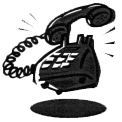![]() by Mark Margulies
by Mark Margulies
It wasn’t his fault. Alexander Graham Bell had no idea of what he was doing when he called Watson that fateful day and opened up the world’s ears to the invention of the telephone. In truth, Bell did more than invent a new device for communicating. He created the first example of the most infamous of all beefs in radio today: extraneous copy information.
 Phone numbers for boutiques, furniture stores, or bookstores. Directions on how to get to the client’s place of business. Daily specials for the week. It’s extraneous copy information that most clients demand, imagining it all to be essential to the success of their ad. In truth all it ends up being in most cases is a huge waste of time.
Phone numbers for boutiques, furniture stores, or bookstores. Directions on how to get to the client’s place of business. Daily specials for the week. It’s extraneous copy information that most clients demand, imagining it all to be essential to the success of their ad. In truth all it ends up being in most cases is a huge waste of time.
As a creative director-copywriter-you-know-who-you-are-so-enough-with-the-hyphens-already, this glut is not only creative death, it will inhibit your ability to produce anything that contains the targeted and focused information necessary to get an audience involved and motivated. Therefore, it is essential that you begin the process of surgically removing this problem before it strangles you and the client to death.
The first place to start is to remember what we are and what we are not. We are NOT television. We are NOT print. We do not have a product people can see, feel, reread, and touch. What we have is fifteen, thirty, or sixty seconds to make an impression, an impression that may only happen if we single out a specific target audience, and then tell them what is required--they should call, write, go to, see, etc.. Information that clutters a spot or does not relate to the client’s attempted goal is not helpful nor beneficial. Therefore, if a furniture store is judging you by the number of people who show up the following weekend, as opposed to calling about a product or special, a phone number will have very little bearing on your success. Of course, the flip side is, if the phone number is ESSENTIAL (pizza delivery, restaurant for carry-out, 800 services, etc.), then it has to be the focal point of the spot and drilled home time and time again. And thus, don’t clutter a spot like this with address, directions, etc., either. Either way, keep it crisp, lean, and clean.
However, this is a tough matter to address when dealing with a client, because clients have comfort zones. One of the most prevalent is the, “I MUST HAVE MY ADDRESS AND PHONE NUMBER OR ELSE MY SPOT WILL DIE” zone. So a good trick to use is to have the Account Executive show the owner some station collateral that contains a difficult phone number (ex: 2-6-2-0-9-6-1 as opposed to 2-2-2-5-thousand). Then, in a couple of minutes, ask for the number. If they haven’t been paying attention, they won’t remember the number. Same principle applies to their listening audience. If the listener isn’t being driven to an action that asks them to make a call, how are they supposed to capture the number having heard it for a few brief seconds? And if they don’t capture it, how important is it overall?
A phone number in most cases is the most incorrigible waste of time in radio today (except as in the example noted above where it’s the reason for being in business). And the fact is, unless it’s an easy number to remember (ex:2-2-2-5-thousand, or 1-800-BUY-THIS) most people are not going to get it. Why? Because in most cases your audience is mobile. Who has time to find a pen and paper while cruising along on the interstate system or side roads to write a number down? It makes transmitting phone numbers difficult. Yet in spite of all this, there is another breed of cat to deal with completely. Namely, MULTIPLE phone numbers.
Multiple phone numbers are radio suicide and should be handled in a safe, effective and in one case, profitable way. First, and most profitably, if there are multiple numbers because of multiple locations, suggest an ad featuring the various numbers on a 1:1 rotation (accompanied by the appropriate upsell in spot frequency). The other method is simply to direct the audience to use their local white or yellow pages. This solves your problem handily.
But what about other clutter described earlier? What about directions, family histories, and the like? Well, the good news is, at times, you can use it as a jumping off point for a creative idea. For instance, basing a series of spots on a family’s “colorful” history subtly reinforces their longevity in the community while the spots work to focus on a different aspect the client wishes to highlight. But if it’s just information for the sake of filling time, remember your FOCUS. Remember what the client is expecting your station to do for them. Stay on target, and when you eliminate information that violates the client’s comfort zones, be gentle, be firm, but explain why it’s not a good idea to include it. It’s your job, and your client. An Account Executive will thank you.
Be more than just a production genius. Be an advisor. Help steer both your client and Account Executive in the right direction and help them avoid the rocks. They’ll appreciate your input. They’ll admire your expertise, and they’ll love you to tears when their hard-earned money yields success. That is the ultimate reward.
♦

